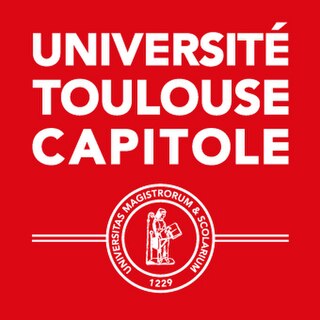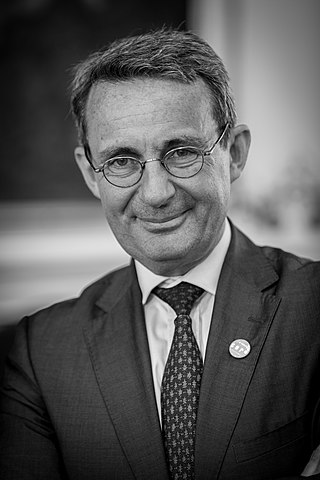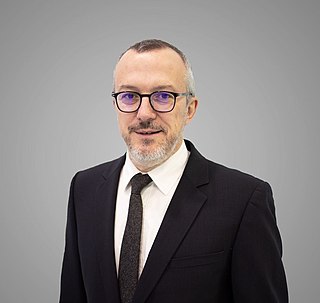
The French National Centre for Scientific Research is the French state research organisation and is the largest fundamental science agency in Europe.
Patou, formerly known as Jean Patou or Jean Patou Paris, is a French fashion house.
The Institut National des Sciences Appliquées de Toulouse is a French grande école of engineering, under the authority of the French Ministry of Education and Research. Situated in Toulouse, this school is one of the 6 state engineering institutes that compose the INSA's network.

Toulouse Capitole University is a public university in Toulouse, France. It is one of the three universities of the city of Toulouse, in southwestern France. The university, presided by Hugues Kenfack, focuses on social sciences, law, political science, economics and administration. An active member of the federal University of Toulouse, it became an experimental public institution on January 1, 2023.
Dalloz is a French publisher that specializes in legal matters and is France's main legal publisher. It was founded by Désiré Dalloz and his brother Armand in 1845. Dalloz was acquired by Groupe de La Cite in 1989. CEP acquired almost complete control of Groupe de La Cite in 1995. Havas acquired full ownership of CEP in 1997 and In 1998, Havas was acquired by the company that became Vivendi. Presses de la Cité became part of Vivendi Universal Publishing (VUP), which in 2002 was sold to Hachette Group. In 2011, Dalloz's turnover amounted to 51,256,788 euros, rising steadily since the creation of the company.
Def2shoot is a motion picture and advertising visual effects company, founded in 2002 and established in Paris, France. The firm has gained popularity in the French visual effects and CGI industry.

Paul Sabatier University is a French university, in the Academy of Toulouse. It is one of the several successor universities of the University of Toulouse.

Bouhans is a commune in the Saône-et-Loire department in the region of Bourgogne-Franche-Comté in eastern France.
Institut de Mathématiques de Toulouse is a research laboratory of the mathematics community of the Toulouse area in France. It is partially supported by the French public research agency CNRS as unit UMR 5129. In 2020 the research in IMT is organized into six main teams, with some overlap:
The Institut de Mécanique des Fluides de Toulouse is a joint research laboratory involving the National Polytechnic Institute of Toulouse (INPT), the French National Centre for Scientific Research (CNRS) and the Paul Sabatier University. The laboratory develops research activities related to the physics of flows.
Bioderma Laboratories is a privately owned French pharmaceutical company that specialises in medication for dermatological and hair/scalp conditions, as well as for Pediatry and cell regeneration. It was founded in 1977, in Aix en Provence, where its headquarters still reside. However, in 2001, the company opened its first specialised biometrology lab for skincare research and development in Lyon. Its primary business sector is Dermatology, with products such as ABCDerm, Atoderm, Cicabio, Créaline, Hydrabio, Matriciane, Matricium, Sébium, White Objective, secure, Nodé and Photoderm.

Jean-Christophe Fromantin is a French businessman and politician. He has been Mayor of Neuilly-sur-Seine since 2008.

Patrice Simon is a French chemist in the field of materials science and electrochemistry. He is currently a Distinguished Professor at the Université Paul Sabatier since 2007. His research activities are focused onto the modification of the material/electrolyte interfaces in electrodes for electrochemical energy storage devices such as supercapacitors and batteries. He is also former Director of the European Research Institute "ALISTORE ERI", and currently deputy director of the French Newtwork on Electrochemical Energy Storage (RS2E).
Nanocar Race is an international scientific competition with the aim of testing the performance of molecular machines and the scientific instruments used to control them. The race of the molecules takes place on a 100 nanometer track and was held for the first time in Toulouse on 28 and 29 April 2017.

Rangueil is a residential area south-east of Toulouse in Haute-Garonne, France, where grandes écoles and Universities are located as well as an important scientific complex. It has 2,295 inhabitants (2018).
Anne-Marie Caminade is a French chemist who is Director of Research Exceptional Class at the French National Centre for Scientific Research. Her research considers dendrimers and heterochemistry. She was awarded the 2021 Société chimique de France Achille le Bel Grand Prize.
Charlotte Goetschy-Bolognese is a French politician serving as the member of the National Assembly for the 5th constituency of Haut-Rhin since 2022. She replaces Olivier Becht.
Christine Joblin is a French astrochemist who uses spectroscopy to study photodissociation and the polycyclic aromatic hydrocarbons in cosmic dust. Beyond her experimental and observational work, she also contributed to the first clear finding of buckminsterfullerene in a meteorite, a ureilite that exploded over the Nubian Desert in late 2008. She is a director of research for the French National Centre for Scientific Research (CNRS), affiliated with the Institut de Recherche en Astrophysique et Planétologie in Toulouse.
The Institut Clément Ader is a research laboratory under the supervision of the Institut national des sciences appliquées de Toulouse, the Toulouse III - Paul Sabatier University (UPS), the École des mines d'Albi-Carmaux, the Institut supérieur de l'aéronautique et de l'espace (ISAE-SUPAERO) and the National Center for Scientific Research (CNRS).

The Institut de recherche en informatique de Toulouse (IRIT) is a joint research unit in France, whose main site is located on the campus of Toulouse III - Paul Sabatier University in the Rangueil district of Toulouse, in Occitanie.











